34. the dna viruses ii
1 like420 views
Adelwisa R. Ortega is a medical doctor. Her biography was compiled by Sulochan Lohani. The document provides the name of a medical doctor and identifies the compiler of her biography.
1 of 79
Downloaded 35 times

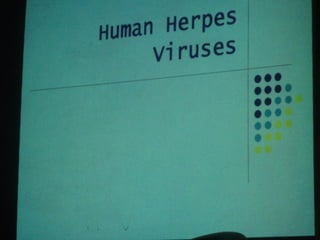
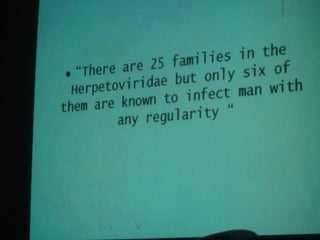
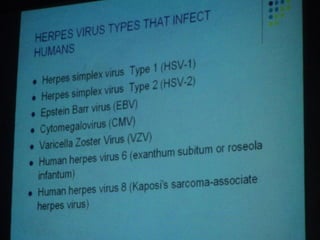

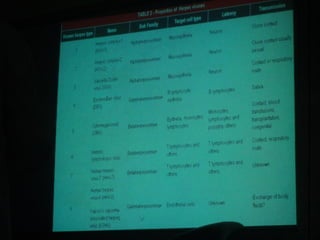
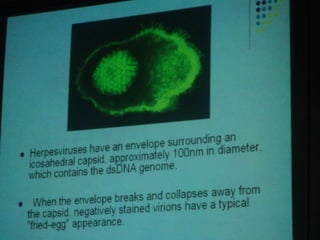

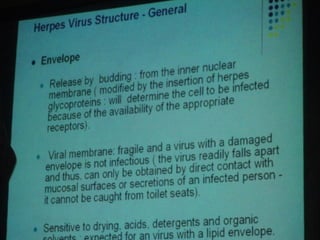
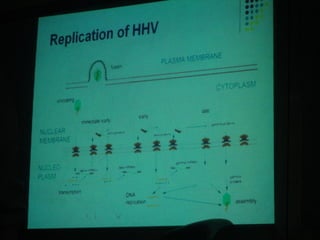
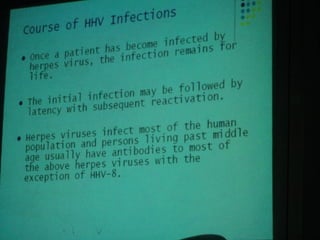
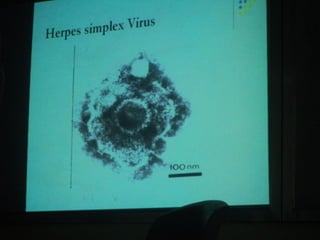


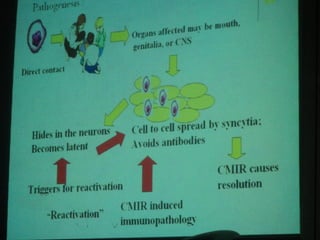
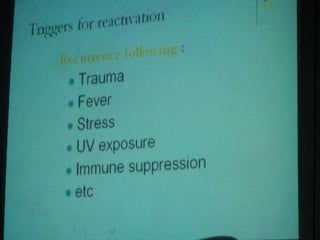


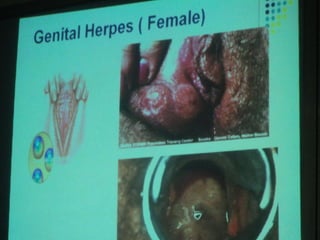


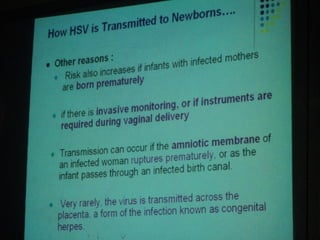


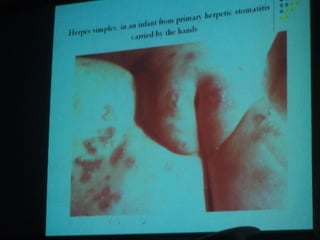

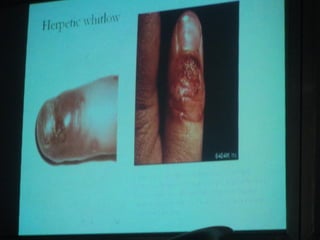

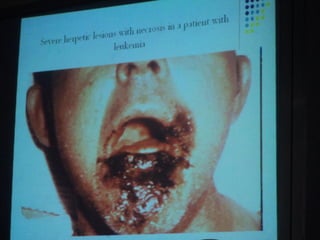



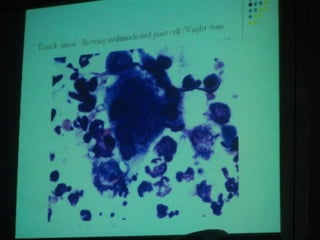
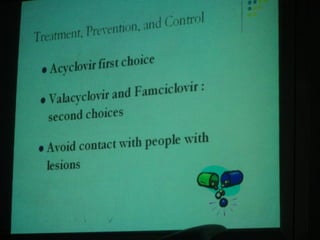

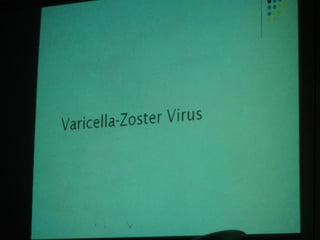
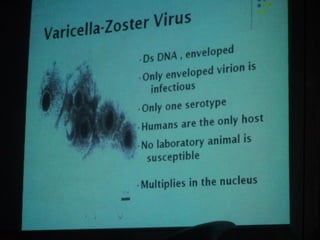
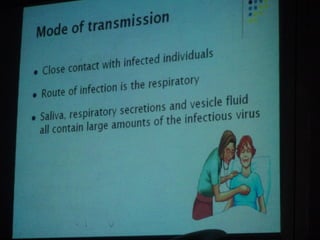
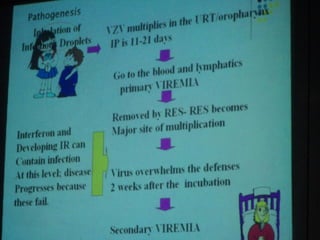
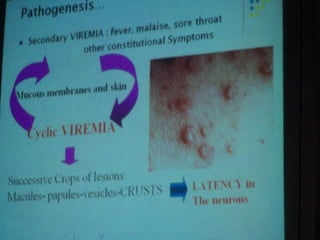

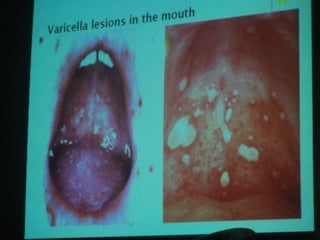
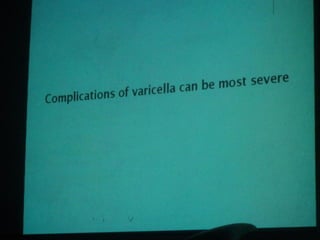


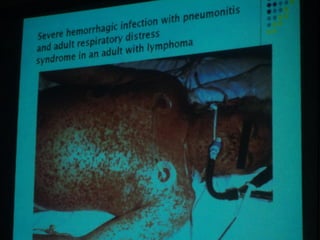

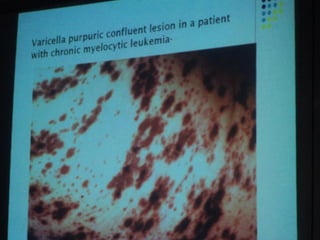
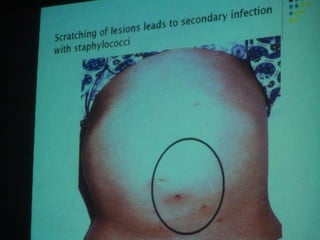


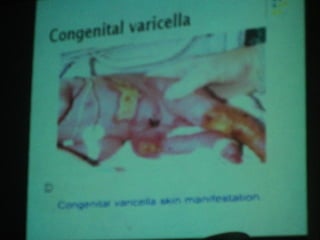

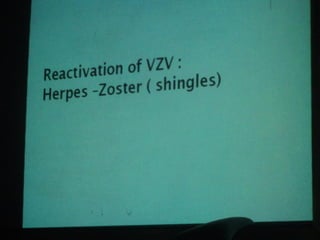
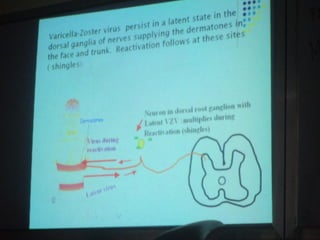


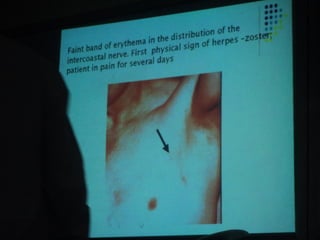

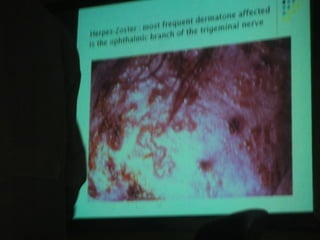

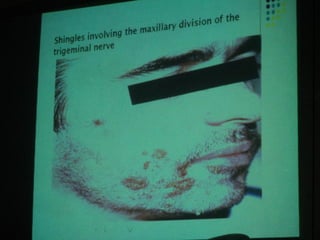
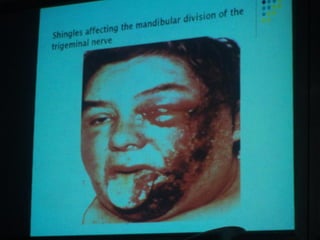
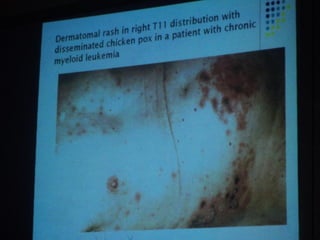

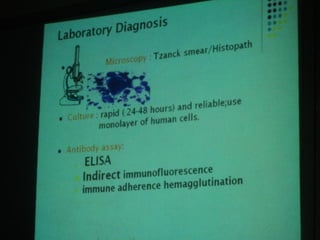
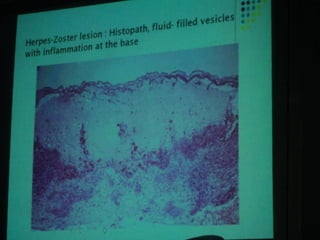
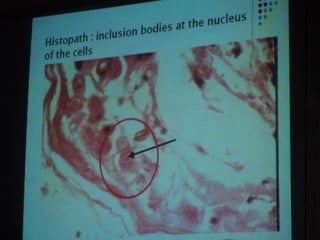





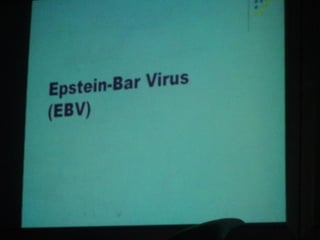


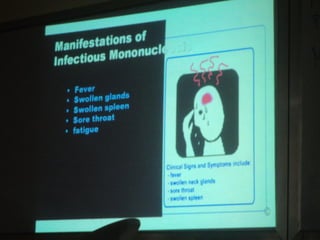
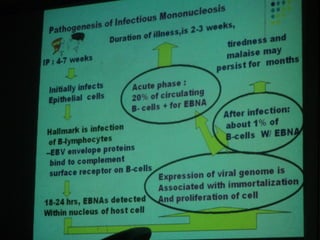

Ad
Recommended
Viruses
Virusessusiataiji
╠²
Viruses are non-cellular infectious agents that have two main characteristics: genetic material and a protein coat. Examples include bacteriophages that infect bacteria, as well as viruses like HIV, SARS, and Ebola. Viruses can multiply through either a lytic or lysogenic pathway. They evolve along with their hosts, and new threats can emerge from pathogens like Ebola, drug-resistant strains, and foodborne illnesses such as Salmonella.32. other pathogenic mechanisms
32. other pathogenic mechanismssulochan_lohani
╠²
This document lists several pathogenic bacteria and microorganisms that can cause diseases: Legionella, Listeria monocytogenesis, Erysipelothriz rhusioopathaiae, streptobacillusmonoliformis, calymmatobacterium (Donovania) granulomatis, Bartonellabacilliformis, and Gardnellavaginalis LAD. The document was compiled by Sulochan Lohani.Viruses
Viruses lulzie_
╠²
This document provides an overview of viruses and viral diseases. It defines viruses as strands of DNA or RNA surrounded by protein that can only replicate inside host cells. Viruses are not considered alive since they lack characteristics of living things, like the ability to reproduce outside a host. The document describes how viruses cause diseases by destroying host cells during replication and release of new virus particles. It also discusses methods to treat and prevent viral diseases, including antiviral drugs and vaccines which trigger antibody production to develop immunity. The document concludes by noting scientists research viruses to develop new disease treatments and explore virus links to cancer.34. the dna viruses i
34. the dna viruses isulochan_lohani
╠²
Adelwisa R. Ortega is a medical doctor. Her credentials were compiled by Sulochan Lohani. The document provides the name and title of Adelwisa R. Ortega and identifies Sulochan Lohani as the compiler of her credentials.Virology (CELL AND CLASSIFICATION OF ORGANISMS)
Virology (CELL AND CLASSIFICATION OF ORGANISMS)Shizuka Wani
╠²
The document discusses the characteristics, replication, and effects of viruses. It covers their size, shape, composition, classification and infectivity. It describes the differences between phages and animal viruses, and between DNA and RNA viruses. It also addresses the cytopathology and organismal effects of viruses, as well as their role in oncogenesis and tumorigenesis.Virus
Viruskmtschida
╠²
Viruses are non-living particles that can only reproduce inside host cells. They are much smaller than bacteria and come in various shapes. Viruses cause diseases like smallpox, influenza, and AIDS. They enter cells and use the cell's machinery to replicate themselves before destroying the cell. While viruses cannot live outside of a host, they have developed ways to spread between hosts, such as through respiratory droplets or animal vectors. The best ways to prevent viral spread are vaccination, good hygiene like handwashing, and avoiding contact with infected bodily fluids.Characteristics of viruses
Characteristics of virusesJessi Dildy
╠²
Viruses are the smallest of all pathogens, ranging from 20-500 nanometers in size, consist of either DNA or RNA surrounded by a protein coat or capsule, and have characteristics of both living and non-living entities. They contain genetic material and can reproduce but only within a host cell by taking over the cell's machinery. Viruses cause infectious disease, come in different shapes, and have the ability to mutate or become dormant.Nomanclature of microbes
Nomanclature of microbesZulcaif Ahmad
╠²
This document discusses the classification of different types of living organisms. It covers the six kingdoms of life - Archaea, Bacteria, Protista, Fungi, Plantae, and Animalia. It describes key characteristics of bacteria, archaea, protists, fungi, plants, animals, and viruses. The classification systems are meant to group organisms based on similarities to better understand and study life forms.06 viruses
06 virusesmrtangextrahelp
╠²
Viruses are infectious agents that require a host cell to replicate. They contain either DNA or RNA, but not both, and use the host cell's machinery to produce new viral components. Newly assembled viruses bud from the host cell to infect others. Viruses have both living characteristics like reproduction and mutation, but lack cellular structures and metabolism of their own.Biology 120 lecture 1 2011 2012
Biology 120 lecture 1 2011 2012Marilen Parungao
╠²
The document provides an introduction to a microbiology lecture, covering definitions of microbiology and microorganisms. It then describes different types of microbes like bacteria, archaea, fungi, protozoa, algae, viruses and prions. It compares their sizes and genome sizes. It also briefly discusses the history of microbiology including early discoveries and debates around spontaneous generation.Rna viruses
Rna virusesGlitzz Rose
╠²
This document discusses RNA viruses. It describes how RNA viruses were discovered and studied using random sequence RNAs. RNA viruses have protein capsids that protect their RNA genomes. Their RNA can be directly used for protein synthesis upon entering a host cell. Retroviruses are a category of RNA virus that use reverse transcriptase to transcribe their RNA into DNA, which can then integrate into the host cell's genome. RNA viruses mutate frequently due to the lack of proofreading by RNA-dependent RNA polymerases during replication, with mutation rates estimated between 10-4 to 10-6 mutations per base pair per generation.Group of Dna viruses and viral vectors
Group of Dna viruses and viral vectorsnida rehman
╠²
This document discusses DNA viruses and viral vectors. It begins by introducing viruses and their classification based on host, morphology, genome, and structures. It then describes the Baltimore classification system for viruses. Viral vectors are discussed as effective means of gene transfer that can be manipulated to express therapeutic genes. Several virus types being investigated for gene delivery are described, including retroviruses, adenoviruses, adeno-associated viruses, and herpes simplex viruses. Key properties of viral vectors like safety, toxicity, stability, and cell specificity are outlined. Specific types of viral vectors - retroviral, lentiviral, adenoviral, adeno-associated viral, and herpes simplex viral vectors - are then characterized.Dna Viruses
Dna VirusesZulkifal Yousaf
╠²
DNA viruses like poxviruses, herpesviruses, and hepatitis B viruses use DNA as their genetic material. Herpesviruses have larger virions and genomes than adenoviruses. They enter cells through fusion with the plasma membrane or endocytosis. During replication, herpesviruses use host enzymes to transcribe early genes that regulate expression of late genes for structural proteins. Virions assemble in the nucleus and acquire an envelope as they bud through the inner nuclear membrane. Viral genomes evolve through spontaneous or induced mutation during replication and by recombining genetic material within or between viruses through breaking and rejoining DNA or RNA.33. an introduction to the viruses
33. an introduction to the virusessulochan_lohani
╠²
Viruses have capsids made of protein subunits that enclose and protect their nucleic acid. Viruses come in two main shapes - helical or icosahedral - determined by the arrangement of capsomers in the capsid. Some viruses have an envelope in addition to the capsid.
Viral replication involves the virus binding to and entering a host cell, then using the cell's machinery to produce new viral components which are assembled and released to infect new cells. DNA and RNA viruses replicate via different mechanisms using virus-specific enzymes. Animal virus replication is more complex than bacterial viruses due to host cell complexity.
Growing viruses requires appropriate cell cultures or animal hosts that provide an environment where the virus can replicateBohomolets Microbiology Lecture #4
Bohomolets Microbiology Lecture #4Dr. Rubz
╠²
The document discusses different types of infectious agents including viruses, viroids, virusoids, and prions. It describes their structures and compositions. Viruses are obligate intracellular parasites that contain their own genome and proteins. Viroids contain only RNA, virusoids contain nucleic acid and a virus capsid, and prions are composed solely of protein. Defective viruses also require a helper virus. The document then discusses the history of virology discoveries and provides comparisons of viruses and cells.Viruses, Viroids, and Prions
Viruses, Viroids, and PrionsMiguel Barba
╠²
Chapter 13 discusses viruses, viroids, and prions, emphasizing their structural characteristics and classification. It explains the life cycles of various viruses, including bacteriophages and animal viruses, as well as the relationships between certain viruses and cancer. Additionally, the chapter covers methods for growing, identifying, and understanding the implications of viral infections, including persistent and latent infections.Standard (+) Rna Virus
Standard (+) Rna Virusraj kumar
╠²
The document discusses RNA viruses from the Togaviridae and Flaviviridae families that cause hemorrhagic fever and encephalitis. It describes the structure and genome of togaviruses like alphaviruses and rubivirus, and flaviviruses like those that cause dengue, yellow fever, and hepatitis C. These viruses are transmitted by arthropods and can cause diseases ranging from mild fevers and rashes to hemorrhagic fever, encephalitis, and congenital rubella syndrome. Vaccines exist for some viruses like rubella and yellow fever.general organization and characterstics of virus
general organization and characterstics of virusMohd Asif Kanth
╠²
Viruses are nonliving infectious agents that contain either DNA or RNA surrounded by a protein coat called a capsid. They can only reproduce inside of living host cells by hijacking the cell's machinery to produce more viruses. Viruses vary greatly in size and morphology, ranging from 10-400 nanometers, and some have an additional outer envelope acquired from the host cell membrane. They exhibit both living characteristics like reproduction and mutation, as well as nonliving characteristics as they do not metabolize or divide outside of host cells.Dna Virus
Dna Virusraj kumar
╠²
The document summarizes human DNA viruses, including their structure, replication cycles, and associated diseases. It covers adenoviruses, herpesviruses, papovaviruses, parvoviruses, poxviruses, and hepadnaviruses. Adenoviruses use host cell machinery to replicate their DNA and assemble new virus particles that ultimately cause cell lysis. Herpesviruses and papovaviruses replicate through rolling circle mechanisms. Parvoviruses and hepadnaviruses have unique replication features. Poxviruses are the only DNA viruses that replicate in the cytoplasm.dna and rna Viruses
dna and rna Viruses Zulkifal Yousaf
╠²
Viruses are biological agents that reproduce inside host cells. They contain genetic material in the form of DNA or RNA and a protein coat. Viruses come in various shapes and sizes, and there are over 2,000 known virus species that can infect humans and cause diseases like influenza, hepatitis C, and SARS. Viruses have a life cycle where they attach and penetrate a host cell, use the cell to replicate their genetic material and proteins, assemble new virus particles, and are released to infect new cells. Viruses are classified based on their genetic material and structure. Important human virus families include those with RNA genomes like influenza virus and those with DNA genomes like adenovirus.Chapter 19 lecture- Viruses & Bacteria
Chapter 19 lecture- Viruses & BacteriaMary Beth Smith
╠²
The document discusses bacteria and viruses. It describes that prokaryotes like bacteria are classified into eubacteria and archaebacteria based on cell wall composition. Viruses require a living host cell to reproduce and can cause lytic or lysogenic infections. Bacteria and viruses can cause diseases in humans and plants through various mechanisms.Viruses ppt
Viruses pptMuhammad Fahad Saleh
╠²
Viruses exist at the boundary between living and non-living things. They consist of nucleic acids and proteins but cannot reproduce outside of a host cell. Viruses come in different shapes and sizes and have unique structures suited to their method of infection. They hijack the machinery of living cells to reproduce either through lytic or lysogenic cycles, ultimately resulting in the destruction of the host cell. While viruses rely on host cells, they are not considered alive as they do not have their own metabolism or respond to their environment.Viruses
VirusesKerOro SUn
╠²
This document provides an overview of viruses, including their history of discovery, characteristics, components, shapes, classification, bacteriophages, replication cycles, enveloped viruses, and other related infectious agents like viroids and prions. It discusses key scientists and experiments that contributed to the understanding of viruses. The replication cycles of lytic and lysogenic bacteriophages as well as enveloped DNA and RNA viruses are described.Chapter 2 classification of virus
Chapter 2 classification of virusAlia Najiha
╠²
This document provides an overview of virus classification and the Baltimore classification system. It begins with an introduction to naming conventions for viruses and general approaches to classification. It then describes the Baltimore classification in detail, which divides viruses into 7 classes based on their genome type and replication strategy. The classification focuses on whether the viral nucleic acids are DNA or RNA, and if they are single- or double-stranded. Key viral families are listed as examples for each class.Virus ppt
Virus pptrajendra dangol
╠²
This document defines viruses and summarizes their key characteristics and classification. It describes how viruses were first discovered through experiments filtering bacteria and plant extracts. Viruses are non-cellular particles that contain genetic material and invade living cells. They are smaller than bacteria, contain either DNA or RNA, and lack organelles. Viruses replicate only inside host cells and do not undergo binary fission. They have various structures depending on their nucleic acid arrangement and symmetry. Viruses are classified into groups based on their nucleic acids and ability to produce mRNA.virus powerpoint
virus powerpointkmtschida
╠²
Viruses are non-living particles that can only reproduce inside host cells. They are smaller than bacteria and contain genetic material surrounded by a protein coat. Viruses come in various shapes and sizes and cause diseases like influenza, measles, HIV/AIDS, and some cancers. Edward Jenner developed the first vaccine for smallpox using a related cowpox virus. Viruses are identified based on their morphology, genetic material, presence of an envelope, capsid shape, host cell, and more. They exist in nature as parasites and depend on host cells for reproduction through lysogenic or lytic cycles.10. fluids and electrolytes
10. fluids and electrolytessulochan_lohani
╠²
This document discusses fluid and electrolyte composition and regulation in the body. It covers the following key points:
- Total body water is divided into intracellular fluid and extracellular fluid, which are in osmotic equilibrium.
- The hypothalamus and kidneys work together to regulate osmolality and fluid volume through antidiuretic hormone and sodium balance.
- Sodium is the principal extracellular cation and a key determinant of extracellular fluid volume and osmolality.
- Potassium is mainly intracellular and its concentration is regulated by the sodium-potassium pump and factors like insulin, pH, and aldosterone.
- Hypernatremia and hyponatremia and their causes, signs,35. hepatitis
35. hepatitissulochan_lohani
╠²
The document discusses hepatitis A-G viruses and viral hepatitis. It provides details on the transmission, clinical features, diagnosis, and prevention of hepatitis A and B viruses. Hepatitis A virus is transmitted through the fecal-oral route, has an average incubation period of 30 days, and causes an acute infection with no chronic sequelae. Hepatitis B virus can be transmitted through blood, sexual contact and perinatal transmission. It may cause either an acute infection or develop into a chronic infection associated with long-term liver problems. Laboratory tests are used to diagnose both viruses and vaccines are available to prevent infection.41. laboratory diagnosis of common fungal diseases
41. laboratory diagnosis of common fungal diseasessulochan_lohani
╠²
The document discusses laboratory diagnosis of common fungal diseases. It provides data on clinical specimens submitted for fungal isolation from 2004-2006, with the most common being respiratory and body fluids. The most frequent fungal isolates were Candida albicans, C. tropicalis and C. parapsilosis. Methods for diagnosing mycoses include direct microscopic examination, culture techniques, biochemical tests and special tests. Common superficial cutaneous fungal infections affecting the skin, hair and nails are also described, along with their characteristic lesions, causative organisms and laboratory identification.More Related Content
Viewers also liked (18)
06 viruses
06 virusesmrtangextrahelp
╠²
Viruses are infectious agents that require a host cell to replicate. They contain either DNA or RNA, but not both, and use the host cell's machinery to produce new viral components. Newly assembled viruses bud from the host cell to infect others. Viruses have both living characteristics like reproduction and mutation, but lack cellular structures and metabolism of their own.Biology 120 lecture 1 2011 2012
Biology 120 lecture 1 2011 2012Marilen Parungao
╠²
The document provides an introduction to a microbiology lecture, covering definitions of microbiology and microorganisms. It then describes different types of microbes like bacteria, archaea, fungi, protozoa, algae, viruses and prions. It compares their sizes and genome sizes. It also briefly discusses the history of microbiology including early discoveries and debates around spontaneous generation.Rna viruses
Rna virusesGlitzz Rose
╠²
This document discusses RNA viruses. It describes how RNA viruses were discovered and studied using random sequence RNAs. RNA viruses have protein capsids that protect their RNA genomes. Their RNA can be directly used for protein synthesis upon entering a host cell. Retroviruses are a category of RNA virus that use reverse transcriptase to transcribe their RNA into DNA, which can then integrate into the host cell's genome. RNA viruses mutate frequently due to the lack of proofreading by RNA-dependent RNA polymerases during replication, with mutation rates estimated between 10-4 to 10-6 mutations per base pair per generation.Group of Dna viruses and viral vectors
Group of Dna viruses and viral vectorsnida rehman
╠²
This document discusses DNA viruses and viral vectors. It begins by introducing viruses and their classification based on host, morphology, genome, and structures. It then describes the Baltimore classification system for viruses. Viral vectors are discussed as effective means of gene transfer that can be manipulated to express therapeutic genes. Several virus types being investigated for gene delivery are described, including retroviruses, adenoviruses, adeno-associated viruses, and herpes simplex viruses. Key properties of viral vectors like safety, toxicity, stability, and cell specificity are outlined. Specific types of viral vectors - retroviral, lentiviral, adenoviral, adeno-associated viral, and herpes simplex viral vectors - are then characterized.Dna Viruses
Dna VirusesZulkifal Yousaf
╠²
DNA viruses like poxviruses, herpesviruses, and hepatitis B viruses use DNA as their genetic material. Herpesviruses have larger virions and genomes than adenoviruses. They enter cells through fusion with the plasma membrane or endocytosis. During replication, herpesviruses use host enzymes to transcribe early genes that regulate expression of late genes for structural proteins. Virions assemble in the nucleus and acquire an envelope as they bud through the inner nuclear membrane. Viral genomes evolve through spontaneous or induced mutation during replication and by recombining genetic material within or between viruses through breaking and rejoining DNA or RNA.33. an introduction to the viruses
33. an introduction to the virusessulochan_lohani
╠²
Viruses have capsids made of protein subunits that enclose and protect their nucleic acid. Viruses come in two main shapes - helical or icosahedral - determined by the arrangement of capsomers in the capsid. Some viruses have an envelope in addition to the capsid.
Viral replication involves the virus binding to and entering a host cell, then using the cell's machinery to produce new viral components which are assembled and released to infect new cells. DNA and RNA viruses replicate via different mechanisms using virus-specific enzymes. Animal virus replication is more complex than bacterial viruses due to host cell complexity.
Growing viruses requires appropriate cell cultures or animal hosts that provide an environment where the virus can replicateBohomolets Microbiology Lecture #4
Bohomolets Microbiology Lecture #4Dr. Rubz
╠²
The document discusses different types of infectious agents including viruses, viroids, virusoids, and prions. It describes their structures and compositions. Viruses are obligate intracellular parasites that contain their own genome and proteins. Viroids contain only RNA, virusoids contain nucleic acid and a virus capsid, and prions are composed solely of protein. Defective viruses also require a helper virus. The document then discusses the history of virology discoveries and provides comparisons of viruses and cells.Viruses, Viroids, and Prions
Viruses, Viroids, and PrionsMiguel Barba
╠²
Chapter 13 discusses viruses, viroids, and prions, emphasizing their structural characteristics and classification. It explains the life cycles of various viruses, including bacteriophages and animal viruses, as well as the relationships between certain viruses and cancer. Additionally, the chapter covers methods for growing, identifying, and understanding the implications of viral infections, including persistent and latent infections.Standard (+) Rna Virus
Standard (+) Rna Virusraj kumar
╠²
The document discusses RNA viruses from the Togaviridae and Flaviviridae families that cause hemorrhagic fever and encephalitis. It describes the structure and genome of togaviruses like alphaviruses and rubivirus, and flaviviruses like those that cause dengue, yellow fever, and hepatitis C. These viruses are transmitted by arthropods and can cause diseases ranging from mild fevers and rashes to hemorrhagic fever, encephalitis, and congenital rubella syndrome. Vaccines exist for some viruses like rubella and yellow fever.general organization and characterstics of virus
general organization and characterstics of virusMohd Asif Kanth
╠²
Viruses are nonliving infectious agents that contain either DNA or RNA surrounded by a protein coat called a capsid. They can only reproduce inside of living host cells by hijacking the cell's machinery to produce more viruses. Viruses vary greatly in size and morphology, ranging from 10-400 nanometers, and some have an additional outer envelope acquired from the host cell membrane. They exhibit both living characteristics like reproduction and mutation, as well as nonliving characteristics as they do not metabolize or divide outside of host cells.Dna Virus
Dna Virusraj kumar
╠²
The document summarizes human DNA viruses, including their structure, replication cycles, and associated diseases. It covers adenoviruses, herpesviruses, papovaviruses, parvoviruses, poxviruses, and hepadnaviruses. Adenoviruses use host cell machinery to replicate their DNA and assemble new virus particles that ultimately cause cell lysis. Herpesviruses and papovaviruses replicate through rolling circle mechanisms. Parvoviruses and hepadnaviruses have unique replication features. Poxviruses are the only DNA viruses that replicate in the cytoplasm.dna and rna Viruses
dna and rna Viruses Zulkifal Yousaf
╠²
Viruses are biological agents that reproduce inside host cells. They contain genetic material in the form of DNA or RNA and a protein coat. Viruses come in various shapes and sizes, and there are over 2,000 known virus species that can infect humans and cause diseases like influenza, hepatitis C, and SARS. Viruses have a life cycle where they attach and penetrate a host cell, use the cell to replicate their genetic material and proteins, assemble new virus particles, and are released to infect new cells. Viruses are classified based on their genetic material and structure. Important human virus families include those with RNA genomes like influenza virus and those with DNA genomes like adenovirus.Chapter 19 lecture- Viruses & Bacteria
Chapter 19 lecture- Viruses & BacteriaMary Beth Smith
╠²
The document discusses bacteria and viruses. It describes that prokaryotes like bacteria are classified into eubacteria and archaebacteria based on cell wall composition. Viruses require a living host cell to reproduce and can cause lytic or lysogenic infections. Bacteria and viruses can cause diseases in humans and plants through various mechanisms.Viruses ppt
Viruses pptMuhammad Fahad Saleh
╠²
Viruses exist at the boundary between living and non-living things. They consist of nucleic acids and proteins but cannot reproduce outside of a host cell. Viruses come in different shapes and sizes and have unique structures suited to their method of infection. They hijack the machinery of living cells to reproduce either through lytic or lysogenic cycles, ultimately resulting in the destruction of the host cell. While viruses rely on host cells, they are not considered alive as they do not have their own metabolism or respond to their environment.Viruses
VirusesKerOro SUn
╠²
This document provides an overview of viruses, including their history of discovery, characteristics, components, shapes, classification, bacteriophages, replication cycles, enveloped viruses, and other related infectious agents like viroids and prions. It discusses key scientists and experiments that contributed to the understanding of viruses. The replication cycles of lytic and lysogenic bacteriophages as well as enveloped DNA and RNA viruses are described.Chapter 2 classification of virus
Chapter 2 classification of virusAlia Najiha
╠²
This document provides an overview of virus classification and the Baltimore classification system. It begins with an introduction to naming conventions for viruses and general approaches to classification. It then describes the Baltimore classification in detail, which divides viruses into 7 classes based on their genome type and replication strategy. The classification focuses on whether the viral nucleic acids are DNA or RNA, and if they are single- or double-stranded. Key viral families are listed as examples for each class.Virus ppt
Virus pptrajendra dangol
╠²
This document defines viruses and summarizes their key characteristics and classification. It describes how viruses were first discovered through experiments filtering bacteria and plant extracts. Viruses are non-cellular particles that contain genetic material and invade living cells. They are smaller than bacteria, contain either DNA or RNA, and lack organelles. Viruses replicate only inside host cells and do not undergo binary fission. They have various structures depending on their nucleic acid arrangement and symmetry. Viruses are classified into groups based on their nucleic acids and ability to produce mRNA.virus powerpoint
virus powerpointkmtschida
╠²
Viruses are non-living particles that can only reproduce inside host cells. They are smaller than bacteria and contain genetic material surrounded by a protein coat. Viruses come in various shapes and sizes and cause diseases like influenza, measles, HIV/AIDS, and some cancers. Edward Jenner developed the first vaccine for smallpox using a related cowpox virus. Viruses are identified based on their morphology, genetic material, presence of an envelope, capsid shape, host cell, and more. They exist in nature as parasites and depend on host cells for reproduction through lysogenic or lytic cycles.More from sulochan_lohani (14)
10. fluids and electrolytes
10. fluids and electrolytessulochan_lohani
╠²
This document discusses fluid and electrolyte composition and regulation in the body. It covers the following key points:
- Total body water is divided into intracellular fluid and extracellular fluid, which are in osmotic equilibrium.
- The hypothalamus and kidneys work together to regulate osmolality and fluid volume through antidiuretic hormone and sodium balance.
- Sodium is the principal extracellular cation and a key determinant of extracellular fluid volume and osmolality.
- Potassium is mainly intracellular and its concentration is regulated by the sodium-potassium pump and factors like insulin, pH, and aldosterone.
- Hypernatremia and hyponatremia and their causes, signs,35. hepatitis
35. hepatitissulochan_lohani
╠²
The document discusses hepatitis A-G viruses and viral hepatitis. It provides details on the transmission, clinical features, diagnosis, and prevention of hepatitis A and B viruses. Hepatitis A virus is transmitted through the fecal-oral route, has an average incubation period of 30 days, and causes an acute infection with no chronic sequelae. Hepatitis B virus can be transmitted through blood, sexual contact and perinatal transmission. It may cause either an acute infection or develop into a chronic infection associated with long-term liver problems. Laboratory tests are used to diagnose both viruses and vaccines are available to prevent infection.41. laboratory diagnosis of common fungal diseases
41. laboratory diagnosis of common fungal diseasessulochan_lohani
╠²
The document discusses laboratory diagnosis of common fungal diseases. It provides data on clinical specimens submitted for fungal isolation from 2004-2006, with the most common being respiratory and body fluids. The most frequent fungal isolates were Candida albicans, C. tropicalis and C. parapsilosis. Methods for diagnosing mycoses include direct microscopic examination, culture techniques, biochemical tests and special tests. Common superficial cutaneous fungal infections affecting the skin, hair and nails are also described, along with their characteristic lesions, causative organisms and laboratory identification.40. tv
40. tvsulochan_lohani
╠²
Viruses can cause cancer through several mechanisms. Small DNA tumor viruses like HPV and adenovirus often integrate into the host genome and express early genes that promote cell cycle progression and prevent apoptosis. This leads to uncontrolled cell growth. Herpesviruses like EBV and KSHV can cause cancer during their latency phase by expressing genes that induce cell activation and proliferation programs. Chronic viral infections may also cause cancer over long periods through prolonged inflammation. Studying virus-associated cancers provides insights into cancer mechanisms and potential new targets for treatment.39. unconventional viruses
39. unconventional virusessulochan_lohani
╠²
Prion diseases, also known as transmissible spongiform encephalopathies, are caused by misfolded prion proteins. Stanley Prusiner coined the term "prion" to describe the infectious proteinaceous particle that causes these diseases. Prion diseases include Kuru, Creutzfeldt-Jakob disease, scrapie, bovine spongiform encephalopathy, and chronic wasting disease in humans and animals. Prion diseases can be infectious, inherited, or sporadic depending on whether they are transmitted between individuals or caused by genetic mutations or spontaneous misfolding of the prion protein.37. rna viruses ii, and prions
37. rna viruses ii, and prionssulochan_lohani
╠²
This document was compiled by Sulochan Lohani and provides information about the compiler. Sulochan Lohani assembled the contents of the document. The only information given is the name of the compiler, Sulochan Lohani, with no other details provided about the contents or purpose of the compiled document.36. rna virus i (picorna, paramyxo and orthomyxo)
36. rna virus i (picorna, paramyxo and orthomyxo)sulochan_lohani
╠²
The document provides a summary compiled by Sulochan Lohani but does not contain any other text. As the document does not contain meaningful content beyond the compiler's name, it cannot be summarized further in 3 sentences or less.18. heart part 1 basic & congestive heart failure
18. heart part 1 basic & congestive heart failuresulochan_lohani
╠²
This document provides information on the structure and function of the normal and diseased heart. It discusses the components of the myocardium, blood supply, effects of aging, types of heart disease, cardiac hypertrophy, and left and right sided heart failure. Congestive heart failure is characterized by diminished cardiac output and backflow of blood, with morphological changes in the lungs, kidneys, liver, and brain.Blood vesseles ii
Blood vesseles iisulochan_lohani
╠²
This document was compiled by Sulochan Lohani and provides information about the compiler. Sulochan Lohani assembled the contents of the document. The only information given is the name of the compiler, Sulochan Lohani, with no other details provided about the contents or purpose of the compiled document.Nutritional pathology
Nutritional pathologysulochan_lohani
╠²
Nutrition plays a vital role in human health and disease. An imbalance or deficiency in nutrients can lead to various pathological conditions in the body. Maintaining a balanced diet with all essential nutrients is important for overall well-being and disease prevention.Blood vessels disorders i
Blood vessels disorders isulochan_lohani
╠²
The document contains the name "E.C. Eclarin, MD" which likely refers to a medical doctor. There is no other information provided about the person. The document also lists "Compiled by Sulochan Lohani" which suggests Sulochan Lohani compiled or assembled this document containing E.C. Eclarin's name. However, no other context is given about the purpose or content of the compiled document.Blood vesseles ii
Blood vesseles iisulochan_lohani
╠²
This document was compiled by Sulochan Lohani and provides information about the compiler. Sulochan Lohani assembled the contents of the document. The only information given is the name of the compiler, Sulochan Lohani, with no other details provided about the contents or purpose of the compiled document.33. introduction to virology
33. introduction to virologysulochan_lohani
╠²
The document provides a brief history of smallpox and the development of vaccination. It describes how Edward Jenner used cowpox pus to inoculate and prevent smallpox in the 18th century. It then summarizes the World Health Organization's smallpox eradication program from 1967 to 1979 and contemporary concerns about smallpox being used for bioterrorism.Ad
Recently uploaded (20)
AI Agents and FME: A How-to Guide on Generating Synthetic Metadata
AI Agents and FME: A How-to Guide on Generating Synthetic MetadataSafe Software
╠²
In the world of AI agents, semantics is king. Good metadata is thus essential in an organization's AI readiness checklist. But how do we keep up with the massive influx of new data? In this talk we go over the tips and tricks in generating synthetic metadata for the consumption of human users and AI agents alike.Raman Bhaumik - Passionate Tech Enthusiast
Raman Bhaumik - Passionate Tech EnthusiastRaman Bhaumik
╠²
A Junior Software Developer with a flair for innovation, Raman Bhaumik excels in delivering scalable web solutions. With three years of experience and a solid foundation in Java, Python, JavaScript, and SQL, she has streamlined task tracking by 20% and improved application stability.From Manual to Auto Searching- FME in the Driver's Seat
From Manual to Auto Searching- FME in the Driver's SeatSafe Software
╠²
Finding a specific car online can be a time-consuming task, especially when checking multiple dealer websites. A few years ago, I faced this exact problem while searching for a particular vehicle in New Zealand. The local classified platform, Trade Me (similar to eBay), wasnŌĆÖt yielding any results, so I expanded my search to second-hand dealer sitesŌĆöonly to realise that periodically checking each one was going to be tedious. ThatŌĆÖs when I noticed something interesting: many of these websites used the same platform to manage their inventories. Recognising this, I reverse-engineered the platformŌĆÖs structure and built an FME workspace that automated the search process for me. By integrating API calls and setting up periodic checks, I received real-time email alerts when matching cars were listed. In this presentation, IŌĆÖll walk through how I used FME to save hours of manual searching by creating a custom car-finding automation system. While FME canŌĆÖt buy a car for youŌĆöyetŌĆöit can certainly help you find the one youŌĆÖre after!Quantum AI Discoveries: Fractal Patterns Consciousness and Cyclical Universes
Quantum AI Discoveries: Fractal Patterns Consciousness and Cyclical UniversesSaikat Basu
╠²
Embark on a cosmic journey exploring the intersection of quantum
computing, consciousness, and ancient wisdom. Together we'll uncover the
recursive patterns that bind our reality.Wenn alles versagt - IBM Tape sch├╝tzt, was z├żhlt! Und besonders mit dem neust...
Wenn alles versagt - IBM Tape sch├╝tzt, was z├żhlt! Und besonders mit dem neust...Josef Weingand
╠²
IBM LTO10Smarter Aviation Data Management: Lessons from Swedavia Airports and Sweco
Smarter Aviation Data Management: Lessons from Swedavia Airports and SwecoSafe Software
╠²
Managing airport and airspace data is no small task, especially when youŌĆÖre expected to deliver it in AIXM format without spending a fortune on specialized tools. But what if there was a smarter, more affordable way?
Join us for a behind-the-scenes look at how Sweco partnered with Swedavia, the Swedish airport operator, to solve this challenge using FME and Esri.
Learn how they built automated workflows to manage periodic updates, merge airspace data, and support data extracts ŌĆō all while meeting strict government reporting requirements to the Civil Aviation Administration of Sweden.
Even better? Swedavia built custom services and applications that use the FME Flow REST API to trigger jobs and retrieve results ŌĆō streamlining tasks like securing the quality of new surveyor data, creating permdelta and baseline representations in the AIS schema, and generating AIXM extracts from their AIS data.
To conclude, FME expert Dean Hintz will walk through a GeoBorders reading workflow and highlight recent enhancements to FMEŌĆÖs AIXM (Aeronautical Information Exchange Model) processing and interpretation capabilities.
Discover how airports like Swedavia are harnessing the power of FME to simplify aviation data management, and how you can too.Oh, the Possibilities - Balancing Innovation and Risk with Generative AI.pdf
Oh, the Possibilities - Balancing Innovation and Risk with Generative AI.pdfPriyanka Aash
╠²
Oh, the Possibilities - Balancing Innovation and Risk with Generative AIWebdriverIO & JavaScript: The Perfect Duo for Web Automation
WebdriverIO & JavaScript: The Perfect Duo for Web Automationdigitaljignect
╠²
In todayŌĆÖs dynamic digital landscape, ensuring the quality and dependability of web applications is essential. While Selenium has been a longstanding solution for automating browser tasks, the integration of WebdriverIO (WDIO) with Selenium and JavaScript marks a significant advancement in automation testing. WDIO enhances the testing process by offering a robust interface that improves test creation, execution, and management. This amalgamation capitalizes on the strengths of both tools, leveraging SeleniumŌĆÖs broad browser support and WDIOŌĆÖs modern, efficient approach to test automation. As automation testing becomes increasingly vital for faster development cycles and superior software releases, WDIO emerges as a versatile framework, particularly potent when paired with JavaScript, making it a preferred choice for contemporary testing teams."Scaling in space and time with Temporal", Andriy Lupa.pdf
"Scaling in space and time with Temporal", Andriy Lupa.pdfFwdays
╠²
Design patterns like Event Sourcing and Event Streaming have long become standards for building real-time analytics systems. However, when the system load becomes nonlinear with fast and often unpredictable spikes, it's crucial to respond quickly in order not to lose real-time operating itself.
In this talk, IŌĆÖll share my experience implementing and using a tool like Temporal.io. We'll explore the evolution of our system for maintaining real-time report generation and discuss how we use Temporal both for short-lived pipelines and long-running background tasks.Coordinated Disclosure for ML - What's Different and What's the Same.pdf
Coordinated Disclosure for ML - What's Different and What's the Same.pdfPriyanka Aash
╠²
Coordinated Disclosure for ML - What's Different and What's the SameUsing the SQLExecutor for Data Quality Management: aka One man's love for the...
Using the SQLExecutor for Data Quality Management: aka One man's love for the...Safe Software
╠²
The SQLExecutor is one of FMEŌĆÖs most powerful and flexible transformers. Pivvot maintains a robust internal metadata hierarchy used to support ingestion and curation of thousands of external data sources that must be managed for quality before entering our platform. By using the SQLExecutor, Pivvot can efficiently detect problems and perform analysis before data is extracted from our staging environment, removing the need for rollbacks or cycles waisted on a failed job. This presentation will walk through three distinct examples of how Pivvot uses the SQLExecutor to engage its metadata hierarchy and integrate with its Data Quality Management workflows efficiently and within the source postgres database. Spatial Validation ŌĆōValidating spatial prerequisites before entering a production environment. Reference Data Validation - Dynamically validate domain-ed columns across any table and multiple columns per table. Practical De-duplication - Removing identical or near-identical well point locations from two distinct source datasets in the same table.Connecting Data and Intelligence: The Role of FME in Machine Learning
Connecting Data and Intelligence: The Role of FME in Machine LearningSafe Software
╠²
In this presentation, we want to explore powerful data integration and preparation for Machine Learning. FME is known for its ability to manipulate and transform geospatial data, connecting diverse data sources into efficient and automated workflows. By integrating FME with Machine Learning techniques, it is possible to transform raw data into valuable insights faster and more accurately, enabling intelligent analysis and data-driven decision making.AI VIDEO MAGAZINE - June 2025 - r/aivideo
AI VIDEO MAGAZINE - June 2025 - r/aivideo1pcity Studios, Inc
╠²
AI VIDEO MAGAZINE - r/aivideo community newsletter ŌĆō Exclusive Tutorials: How to make an AI VIDEO from scratch, PLUS: How to make AI MUSIC, Hottest ai videos of 2025, Exclusive Interviews, New Tools, Previews, and MORE - JUNE 2025 ISSUE -UserCon Belgium: Honey, VMware increased my bill
UserCon Belgium: Honey, VMware increased my billstijn40
╠²
VMwareŌĆÖs pricing changes have forced organizations to rethink their datacenter cost management strategies. While FinOps is commonly associated with cloud environments, the FinOps Foundation has recently expanded its framework to include ScopesŌĆöand Datacenter is now officially part of the equation. In this session, weŌĆÖll map the FinOps Framework to a VMware-based datacenter, focusing on cost visibility, optimization, and automation. YouŌĆÖll learn how to track costs more effectively, rightsize workloads, optimize licensing, and drive efficiencyŌĆöall without migrating to the cloud. WeŌĆÖll also explore how to align IT teams, finance, and leadership around cost-aware decision-making for on-prem environments. If your VMware bill keeps increasing and you need a new approach to cost management, this session is for you!Security Tips for Enterprise Azure Solutions
Security Tips for Enterprise Azure SolutionsMichele Leroux Bustamante
╠²
Delivering solutions to Azure may involve a variety of architecture patterns involving your applications, APIs data and associated Azure resources that comprise the solution. This session will use reference architectures to illustrate the security considerations to protect your Azure resources and data, how to achieve Zero Trust, and why it matters. Topics covered will include specific security recommendations for types Azure resources and related network security practices. The goal is to give you a breadth of understanding as to typical security requirements to meet compliance and security controls in an enterprise solution.OWASP Barcelona 2025 Threat Model Library
OWASP Barcelona 2025 Threat Model LibraryPetraVukmirovic
╠²
Threat Model Library Launch at OWASP Barcelona 2025
https://owasp.org/www-project-threat-model-library/EIS-Webinar-Engineering-Retail-Infrastructure-06-16-2025.pdf
EIS-Webinar-Engineering-Retail-Infrastructure-06-16-2025.pdfEarley Information Science
╠²
As AI reshapes expectations in retail and B2B commerce, organizations are recognizing a critical reality: meaningful AI outcomes depend on well-structured, adaptable infrastructure. In this session, Seth Earley is joined by Phil Ryan - AI strategist, search technologist, and founder of Glass Leopard Technologies - for a candid conversation on what it truly means to engineer systems for scale, agility, and intelligence.
Phil draws on more than two decades of experience leading search and AI initiatives for enterprise organizations. Together, he and Seth explore the challenges businesses face when legacy architectures limit personalization, agility, and real-time decisioning - and what needs to change to support agentic technologies and next-best-action capabilities.
Key themes from the webinar include:
Composability as a prerequisite for AI╠²- Why modular, loosely coupled systems are essential for adapting to rapid innovation and evolving business needs
Search and relevance as foundational to AI╠²- How techniques honed-in enterprise search have laid the groundwork for more responsive and intelligent customer experiences
From MDM and CDP to agentic systems╠²- How data platforms are evolving to support richer customer context and dynamic orchestration
Engineering for business alignment╠²- Why successful AI programs require architectural decisions grounded in measurable outcomes
The conversation is practical and forward-looking, connecting deep technical understanding with real-world business needs. Whether youŌĆÖre modernizing your commerce stack or exploring how AI can enhance product discovery, personalization, or customer journeys, this session provides a clear-eyed view of the capabilities, constraints, and priorities that matter most.A Constitutional Quagmire - Ethical Minefields of AI, Cyber, and Privacy.pdf
A Constitutional Quagmire - Ethical Minefields of AI, Cyber, and Privacy.pdfPriyanka Aash
╠²
A Constitutional Quagmire - Ethical Minefields of AI, Cyber, and Privacycnc-processing-centers-centateq-p-110-en.pdf
cnc-processing-centers-centateq-p-110-en.pdfAmirStern2
╠²
ū×ū©ūøū¢ ūóūÖūæūĢūōūÖūØ ū¬ūóū®ūÖūÖū¬ūÖ ūæūóū£ 3/4/5 ū”ūÖū©ūÖūØ, ūóūō 22 ūöūŚū£ūżūĢū¬ ūøū£ūÖūØ ūóūØ ūøū£ ūÉūżū®ū©ūĢūÖūĢū¬ ūöūóūÖūæūĢūō ūöūōū©ūĢū®ūĢū¬.╠²ūæūóū£ ū®ūśūŚ ūóūæūĢūōūö ūÆūōūĢū£ ūĢū×ūŚū®ūæ ūĀūĢūŚ ūĢū¦ū£ ū£ūöūżūóū£ūö ūæū®ūżūö ūöūóūæū©ūÖū¬/ū©ūĢūĪūÖū¬/ūÉūĀūÆū£ūÖū¬/ūĪūżū©ūōūÖū¬/ūóū©ūæūÖū¬ ūĢūóūĢūō..
ū×ūĪūĢūÆū£ ū£ūæū”ūó ūżūóūĢū£ūĢū¬ ūóūÖūæūĢūō ū®ūĢūĀūĢū¬ ūöū×ū¬ūÉūÖū×ūĢū¬ ū£ūóūĀūżūÖūØ ū®ūĢūĀūÖūØ: ū¦ūÖūōūĢūŚ ūÉūĀūøūÖ, ūÉūĢūżū¦ūÖ, ūĀūÖūĪūĢū©, ūĢūøū©ūĪūĢūØ ūÉūĀūøūÖ.Ad
34. the dna viruses ii
- 1. Adelwisa R. Ortega, MD Compiled by Sulochan Lohani